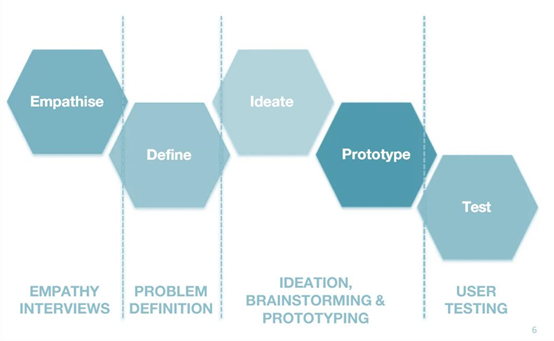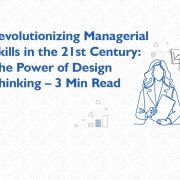Revolutionizing Managerial Skills in the 21st Century: The Power of Design Thinking – 3 Min Read
It is true that problem-solving, decision-making, and creative thinking are highly valued skills in the modern business world, and companies seek managers who possess these skills. However, it is also true that these skills are not always adequately cultivated in management education programs. To address this issue, it is essential to take a practical and hands-on approach to management education. Design Thinking approach can help students develop the 21st-century managerial skills that are in high demand in the job market. One of the benefits of design thinking for management education is that it provides a structured approach to problem-solving that is adaptable to various contexts. It encourages managers to take a user-centered perspective, which involves understanding the needs, desires, and motivations of stakeholders, including customers, employees, and partners. By doing so, managers can create products and services that better meet the needs of their target audience. It fosters creativity and innovation. It encourages managers to challenge assumptions, take risks, and explore new possibilities.
The Evolution of Management: A Comparison of Past and Present Practices
The traditional approach to management education has focused mainly on concepts and theories, with little emphasis on practical skills and real-world applications. In the modern business world, there are three major things that industry needs from managers, ability to fulfil the expectations, needs, and desires of customers, as this century’s emphasis is all about user experience, ability to leverage technology and innovation to create new products, services, and business models, companies that can harness technology effectively can gain a significant competitive advantage.
Out performance by Companies using Design Thinking
It has been seen that design-driven companies have outperformed other companies in terms of financial performance, innovation, and customer satisfaction. According to the DMI Design Value Index, which tracks the performance of design-driven companies, these companies have consistently outperformed the S&P 500 index over the past 10 years by a margin of over 200%. This is because design thinking can help companies develop innovative products and services that meet the needs and desires of customers, and create a positive user experience.

Figure 1 Brown, T. (2008) Design Thinking, Harvard Business Review
- Desirability refers to the need of the users
- Feasibility is how practical is the idea/solution implementable Viability is the money that one puts behind the idea.
Innovative Management through Design Thinking Strategies
When all management schools are looked globally following are the unmet needs:
- Lack of identifying, analysing and practicing how best to manage when faced with economic, institutional and cultural differences.
- Understanding leadership skills, developing alternative approaches of inspiring & influencing.
- Thinking about issues/unstructured situations from variety of perspectives.
- Getting things done in context of hidden agendas, rules, political partnerships and POVs.
- Understanding, synthesizing, and filtering the ambiguous data, generating ideas, experimenting ongoing and learning.
- Thinking critically and communicating clearly.
- Lack of understanding the roles, responsibilities and purpose of business as per different stakeholders & unawareness of models and markets
Navigating the Stages of the Design Thinking Process

Figure 2 Stanford Design Thinking Process
Empathy is the key; it involves understanding the needs of the stakeholders that are affected by the problem. Here managers need to stand in place of stakeholders and understand them.
The Define stage does synthesis of the information they have gathered. This process of defining requires critical thinking i.e., decision-making.
The ideation stage is often seen as the most exciting and enjoyable stage, as it involves generating a wide range of creative and innovative ideas. Students develop the ability of innovation using lateral and divergent thinking and tools to generate ideas.
The refinement and through prototyping happens next with user testing. The testing stage lets them iterate the prototype with their stakeholders.
Cultivating a Managerial Mindset
To be successful in today’s business world, managers need ability to navigate a complex and ever-changing landscape. They need to deal with people and emotions, as well as data and analytical tools. They need to balance creativity and logical thinking, and adapt their mindset as needed to meet the demands of the situation. Organizations need managers who can understand the emotions, creativity to solve problmes, handle chaos and experiences of the customers also use analytical tools & techniques, logical thinking, analysis & synthesis, decision making.



